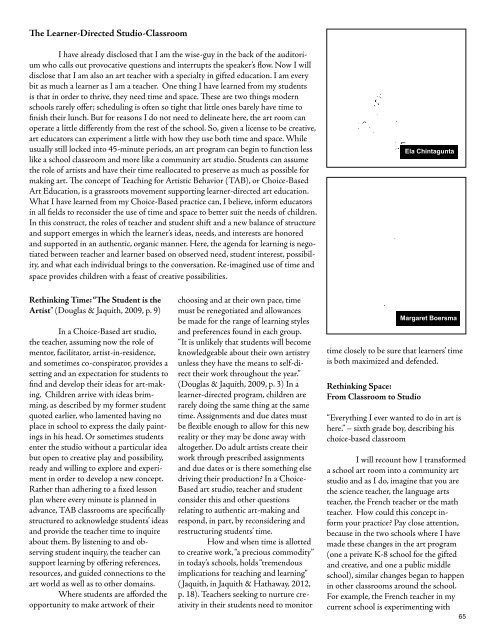Torrance Journal for Applied Creativity
TorranceJournal_V1
TorranceJournal_V1
Create successful ePaper yourself
Turn your PDF publications into a flip-book with our unique Google optimized e-Paper software.
The Learner-Directed Studio-Classroom<br />
I have already disclosed that I am the wise-guy in the back of the auditorium<br />
who calls out provocative questions and interrupts the speaker’s flow. Now I will<br />
disclose that I am also an art teacher with a specialty in gifted education. I am every<br />
bit as much a learner as I am a teacher. One thing I have learned from my students<br />
is that in order to thrive, they need time and space. These are two things modern<br />
schools rarely offer; scheduling is often so tight that little ones barely have time to<br />
finish their lunch. But <strong>for</strong> reasons I do not need to delineate here, the art room can<br />
operate a little differently from the rest of the school. So, given a license to be creative,<br />
art educators can experiment a little with how they use both time and space. While<br />
usually still locked into 45-minute periods, an art program can begin to function less<br />
like a school classroom and more like a community art studio. Students can assume<br />
the role of artists and have their time reallocated to preserve as much as possible <strong>for</strong><br />
making art. The concept of Teaching <strong>for</strong> Artistic Behavior (TAB), or Choice-Based<br />
Art Education, is a grassroots movement supporting learner-directed art education.<br />
What I have learned from my Choice-Based practice can, I believe, in<strong>for</strong>m educators<br />
in all fields to reconsider the use of time and space to better suit the needs of children.<br />
In this construct, the roles of teacher and student shift and a new balance of structure<br />
and support emerges in which the learner’s ideas, needs, and interests are honored<br />
and supported in an authentic, organic manner. Here, the agenda <strong>for</strong> learning is negotiated<br />
between teacher and learner based on observed need, student interest, possibility,<br />
and what each individual brings to the conversation. Re-imagined use of time and<br />
space provides children with a feast of creative possibilities.<br />
Ela Chintagunta<br />
Rethinking Time: “The Student is the<br />
Artist” (Douglas & Jaquith, 2009, p. 9)<br />
In a Choice-Based art studio,<br />
the teacher, assuming now the role of<br />
mentor, facilitator, artist-in-residence,<br />
and sometimes co-conspirator, provides a<br />
setting and an expectation <strong>for</strong> students to<br />
find and develop their ideas <strong>for</strong> art-making.<br />
Children arrive with ideas brimming,<br />
as described by my <strong>for</strong>mer student<br />
quoted earlier, who lamented having no<br />
place in school to express the daily paintings<br />
in his head. Or sometimes students<br />
enter the studio without a particular idea<br />
but open to creative play and possibility,<br />
ready and willing to explore and experiment<br />
in order to develop a new concept.<br />
Rather than adhering to a fixed lesson<br />
plan where every minute is planned in<br />
advance, TAB classrooms are specifically<br />
structured to acknowledge students’ ideas<br />
and provide the teacher time to inquire<br />
about them. By listening to and observing<br />
student inquiry, the teacher can<br />
support learning by offering references,<br />
resources, and guided connections to the<br />
art world as well as to other domains.<br />
Where students are af<strong>for</strong>ded the<br />
opportunity to make artwork of their<br />
choosing and at their own pace, time<br />
must be renegotiated and allowances<br />
be made <strong>for</strong> the range of learning styles<br />
and preferences found in each group.<br />
“It is unlikely that students will become<br />
knowledgeable about their own artistry<br />
unless they have the means to self-direct<br />
their work throughout the year.”<br />
(Douglas & Jaquith, 2009, p. 3) In a<br />
learner-directed program, children are<br />
rarely doing the same thing at the same<br />
time. Assignments and due dates must<br />
be flexible enough to allow <strong>for</strong> this new<br />
reality or they may be done away with<br />
altogether. Do adult artists create their<br />
work through prescribed assignments<br />
and due dates or is there something else<br />
driving their production? In a Choice-<br />
Based art studio, teacher and student<br />
consider this and other questions<br />
relating to authentic art-making and<br />
respond, in part, by reconsidering and<br />
restructuring students’ time.<br />
How and when time is allotted<br />
to creative work, “a precious commodity”<br />
in today’s schools, holds “tremendous<br />
implications <strong>for</strong> teaching and learning”<br />
( Jaquith, in Jaquith & Hathaway, 2012,<br />
p. 18). Teachers seeking to nurture creativity<br />
in their students need to monitor<br />
Rethinking Space:<br />
From Classroom to Studio<br />
Margaret Boersma<br />
time closely to be sure that learners’ time<br />
is both maximized and defended.<br />
“Everything I ever wanted to do in art is<br />
here.” – sixth grade boy, describing his<br />
choice-based classroom<br />
I will recount how I trans<strong>for</strong>med<br />
a school art room into a community art<br />
studio and as I do, imagine that you are<br />
the science teacher, the language arts<br />
teacher, the French teacher or the math<br />
teacher. How could this concept in<strong>for</strong>m<br />
your practice? Pay close attention,<br />
because in the two schools where I have<br />
made these changes in the art program<br />
(one a private K-8 school <strong>for</strong> the gifted<br />
and creative, and one a public middle<br />
school), similar changes began to happen<br />
in other classrooms around the school.<br />
For example, the French teacher in my<br />
current school is experimenting with<br />
65


